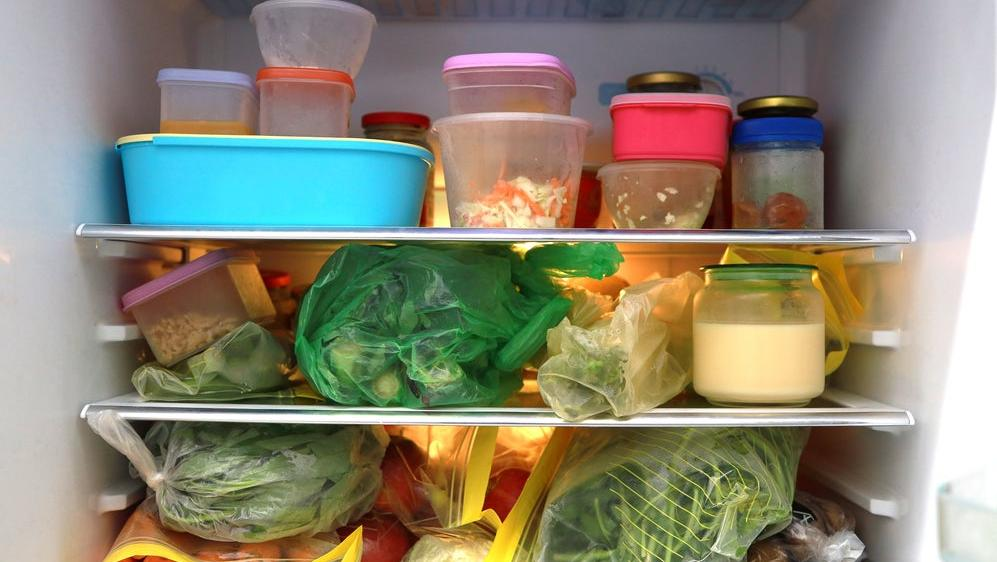Stop Making Your Fridge Work So Hard
Should you really fill in empty fridge space with... sweaters?
Though it's not technically summer yet, as the several boxes of popsicles my kids have already devoured can attest, it's been a hot one already. Summer means the return of some of my favorite food groups: popsicles, hot dogs, ice cream, ice cream, and ice cream (yes, I stock multiple types of ice cream). But, it's hard to celebrate their triumphant return to my grocery list without also mentioning the wee fact that summers are getting hotter and longer. Due to climate change. Which we caused. And should be trying to mitigate.
On the subject of efficiency, summer, and food: Is it more energy-efficient to pack your fridge full of stuff? The theory is that the cold stuff will share its cold, like warm people huddling together on a chilly day to keep each other warm. The Takeout's Marnie Shure said she was introduced to the idea by a friend who, in the interest of keeping their fridge full, used to pack it with sweaters if there was too much empty space. All for the planet.
Does this check out? Is a full fridge more energy-efficient, and should you pack it with sweaters if it's too empty?
To find out, I contacted Efficiency Vermont, a first-of-its-kind publicly regulated energy efficiency utility in Vermont that is charged with helping Vermonters to lower their energy usage. One of the services Efficiency Vermont provides is having energy efficiency experts at the ready to answer energy-related questions from Vermonters, which I am. It's kind of like the Butterball Hotline, but for energy efficiency. I was connected with Margery Haselman, customer support professional.
We tackled the big question first.
Should you put sweaters in your fridge? Like, ever?
"I must say, in the eight years I've been here, I've never heard of anyone putting sweaters in their refrigerator," says Haselman. "Putting jugs of water in the fridge would be a better option, to keep the cold temperature inside of the refrigerator." In other words, something that absorbs and conducts a chill.
Haselman says it is true that a packed fridge would be more energy efficient than an empty one, because of the shared cold. A full fridge would come in handy if the power went out, for example. "If your fridge is at least three-quarters of the way full to full and you lose power, the food will last up to 24 hours," she says. "If it's half full or less, the items in the refrigerator will get warmer faster."
But is it worth keeping a packed fridge all summer? Haselman says the actual difference in energy usage may be negligible, so don't feel like you have to rush to the grocery store right now and come out with a full cart of perishable foods just for the sake of Mother Earth.
"I would say that it would save you energy, but I don't know if it's enough for the effort," she says.
However, there are a few other things she says we should all be doing to keep our fridges as energy efficient as we can.
Ditch the secondary refrigerator
Haselman says if the fridge you're trying to keep full for efficiency is a second fridge, ditch that fridge and stick to one. "If it's possible to consolidate to one refrigerator and unplug the second, that would be the most efficient," says Haselman.
Don’t put hot food directly in the fridge
If food is still hot when it goes into the fridge, it will bring up the temperature of everything in there, which the fridge will then need to work to bring back to a comfortable chill.
"Let it cool on the counter before you put it in so it's not heating up everything in the fridge," says Haselman.
Avoid heat sources near the fridge
Haselman says a fridge in direct sunlight or next to the stove or another heat source must work harder to keep its cool temperature. However, the solution isn't to put it in too cool a place. The goal is to have the fridge in a not-too-hot, not-too-cold space in the house.
Some people mistakenly think that putting a secondary fridge in the garage would help the appliance be more efficient because it's already cold out there, especially in the winter. But, as Haselman explains, any fridge that's in an extreme temperature situation is going to work hard to maintain its status quo, which is around 30 degrees. That's not good for energy usage or the motor.
Clean the coils on the fridge from dust and pet hair
Okay, so, I will admit I had never done this until Haselman told me about it and, woo boy, there's a lot of dust behind the fridge. "Pet hair gets everywhere," says Haselman. "Move the fridge out twice a year and clean the dust."
Check your door seals
Sometimes the door seals on the fridge and freezer doors get dry and then don't create as solid a seal, which means cool can seep out and warm can seep in. Haselman says there are suggestions online to "rejuvenate" the seals, but in her experience, they don't work. Instead, replace the seals altogether.
